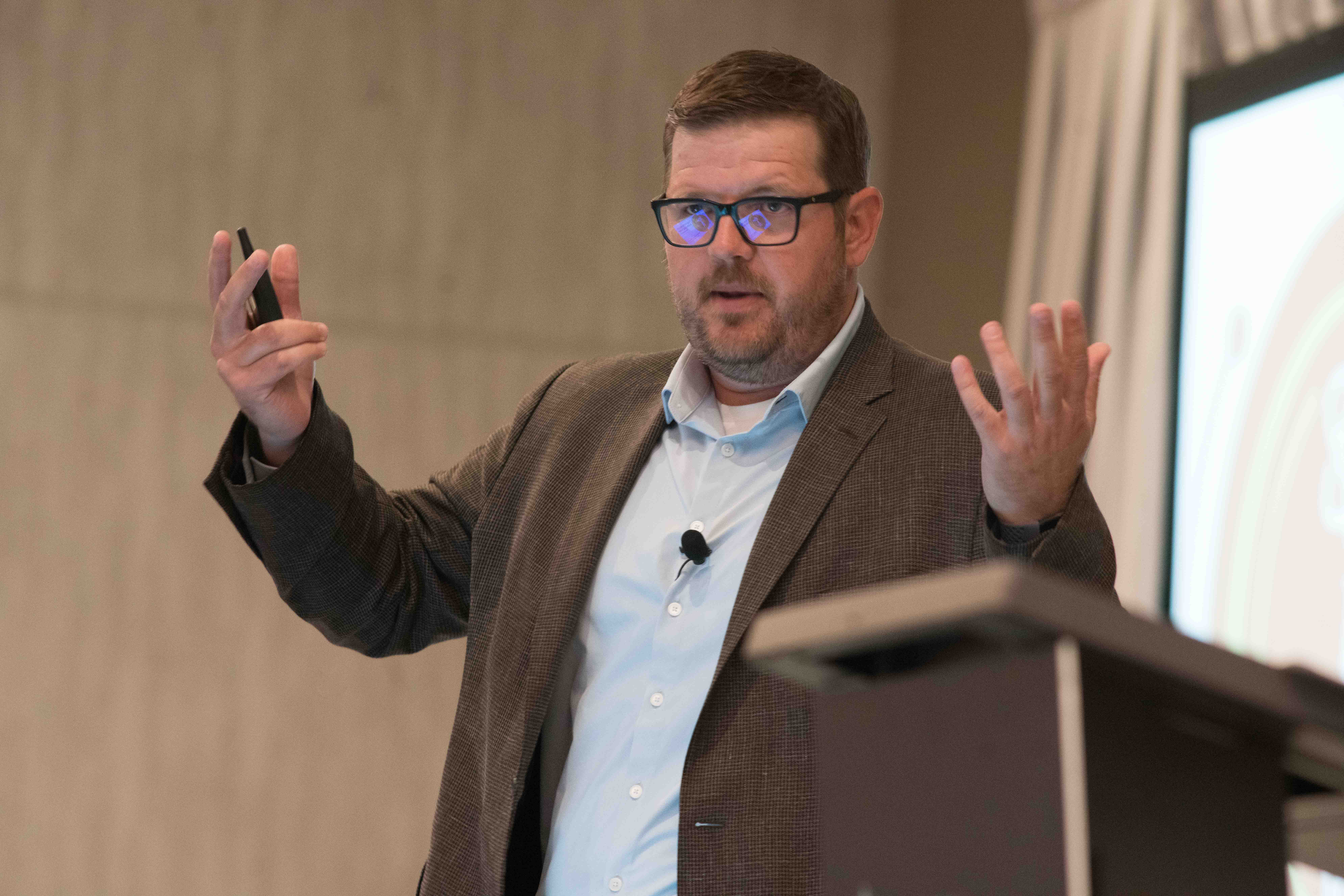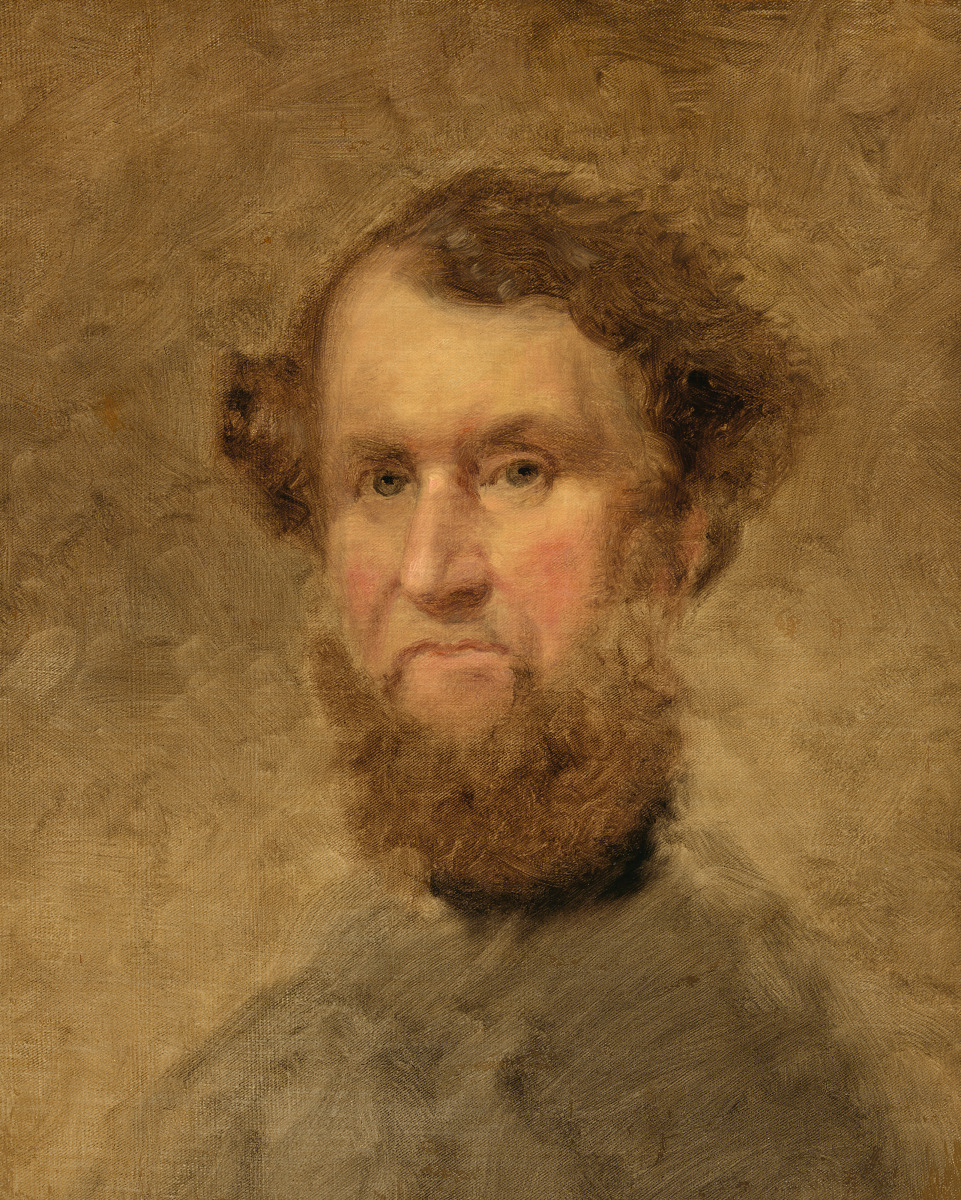
Tim Hammerich speaks during the 4th annual Soybean Research Forum and Think Tank in July. (Photo credit: Joseph Hopper/Iowa Soybean Association, Portrait of Cyrus Hall McCormick: Charles Loring Elliott/Public Domain)
Think Tank Keynote: 3 big ideas and 3 future-drivers
July 31, 2024
Professionals from across the soy complex: farmer leaders, association staff, industry professionals, university academics and more all met in Indianapolis for the fourth annual Soybean Research Forum and Think Tank last week. To kick off the two-day discussion, planning and learning, Podcast Host Tim Hammerich gave the keynote address on a subject he’s familiar with, as it’s the namesake of his popular podcast: the Future of Agriculture.
Idea #1 Make innovation real for the customer
Hammerich drew on ag history during his keynote, pointing out one of the key innovators behind the widespread adoption of the mechanical reaper in the 19th century, Cyrus McCormick, as an example of why it’s important for innovators to hold a radical focus on pleasing the customer. McCormick famously was one of multiple entrepreneurs hoping to make a business out of mechanized farming and had to find success during a trying time in American history – the Civil War era.

“In the 1800s, wheat was still harvested the way it was thousands of years before: sickle, scythe, if you worked hard maybe an acre a day,” Hammerich told the audience. “In 1841 McCormick had the first publicly recorded demonstration of a mechanical reaper. He didn’t patent it that day, but 75 people showed up and exactly zero people purchased anything. He didn’t sell a single mechanical reaper for 10 years.”
Despite being able to show on farms that adoption of his mechanical reaper would transform efficiency from approximately one acre a day per person to eight acres per day, per teams of two, success was elusive for McCormick. The tycoon’s skill at business, marketing and customer relations soon were apparent – to successfully sell his machinery to farmers, he created the first performance guarantee, implemented transparent pricing and offered credit.
With the story of McCormick’s harvester taking place over the course of multiple decades and generations, Hammerich says outside forces will catalyze rapid ag innovation.
“Perhaps we’re starting to see that in some cases with climate right now,” says Hammerich. “Whatever your views on climate change are, we had the Inflation Reduction Act, we’re seeing a big interest from the current administration in climate. That could be a catalyst for a lot of the innovation that has been going on in agriculture for a long time. You could make the argument we’re starting to see that.”
Ideas #2 and #3 Mentorship is important/Innovation can be a slog
Continuing the use of historical figures in American agriculture – Hammerich revisited soy’s origin story in the United States. William J. Morse graduated from Cornell in 1907 and had a lifelong career at the USDA, being mentored by Charles Piper. Morse was a key figure in popularizing soybeans as a crop in the United States and served as the American Soybean Association president from 1923-1925.
“William J. Morse goes to work for the USDA working on soybeans and there’s maybe 1600 acres of soybeans total,” Hammerich says. “And those folks were mostly using it as a forage crop. It’s an obscure forage crop in the southeast, he’s working on it fulltime under his mentor Charles Piper. Through 1907 to the early 1920s this guy was a passionate advocate for the soybean. He would take a train from Virginia where he had his research farm, down to North Carolina. He would rent a wagon and team of horses and go farm to farms, saying ‘try this variety,’ trying to get the word out.”
Morse and his mentor, Piper, later authored one of the early authoritative books on soybeans, which later inspired people like famous automaker Henry Ford’s interest in discovering new uses for soybeans for automobiles. When Morse retired from his career at the USDA, soybean acres in the U.S. reached 11 million.
“Innovation can be a long slog,” Hammerich says. “We are a part of this massive, long history, legacy of innovation. Everything we do is not just because we thought it up, we’re standing on the shoulder of giants to further innovation. When we talk about buzzwords: sustainability, regenerative, AI, the concept, the underlying innovation has been there for a long, long time. One thing I ask myself about William Morse is, could this happen again?”
What factors will drive the future of agriculture?
Hammerich told the Think Tank crowd technology is not always the driver for innovation. He suggested technology would be one part of the solution and outlined a handful of suspected drivers which could impact ag’s future.
1. Globalization/De-globalization
“What does it look like when every person in this room has only been in an economy driven by globalization if that economy would shift to de-globalization?” Hammerich asked. “Where we’re looking at, what can we produce for ourselves? Trade routes are dangerous because of conflict, whatever the case may be. If we don’t have that foreign market of a rapidly growing population year after year, year after year, how do we adjust? What does that look like? If the answer’s not ‘how can we produce more or less?’ maybe ‘how can we produce better? How can we produce in a way that our domestic demand wants to pay us for it?”
2. Policy
“We’ve seen what impact policy can have,” Hammerich says. “It’s something that should not be ignored or left out of any conversation about the future of agriculture.”
3. Economics
“Today we take for granted that farmland values go up,” Hammerich says. “I’m sure some of you in the room have seen them not go up in the past. We likely at some point will encounter a time where they won’t go up over and over in the future. What does that do to the overall economics and the balance sheet of farmers out there?”
Back